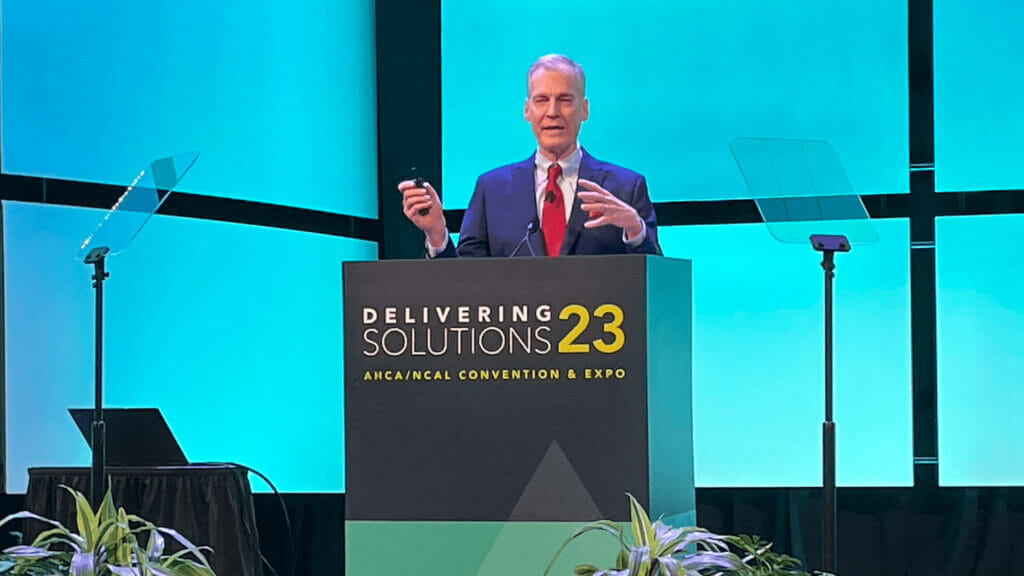

DENVER—The level of needs of older adults moving into assisted living communities today is similar to that of seniors who would move into nursing homes in the past, and if operators and providers don’t train their employees to appropriately address that “acuity creep,” then they are setting themselves up for potential risk, according to Pamela Truscott, DNP/HSL, MSN/ED, RN, National Center for Assisted Living director of quality improvement.
“We’re getting more critically ill residents moving into our sector all the time, and we can’t live in yesterday’s world,” Truscott said during a Sunday panel discussion about increasing resident health needs, held during NCAL Day. “It’s not going to get any better, but there are things we can do to stay on top of that rising acuity need.”
The assisted living-focused event took place a day before the American Health Care Association / NCAL annual convention fully got underway.
Preparing staff for a new resident population
People are living longer, and the average age of an assisted living resident has increased to 87, Truscott said. Older adults often move in with a higher number of chronic conditions than in the past, and a multitude of medications, which equates to increased risk of frailty, she added.
The top consideration for operators is deciding what services and care they are willing to provide, according to panelist Amanda Johnson, RN, Lifespark vice president of operations.
Assisted living providers, she said, often are expected to be able to offer everything. The problem, however, is that few payment models support higher levels of staff certification and care delivery. Johnson added that certified nursing assistants aren’t necessarily recognized as a component in assisted living, meaning that care delivery is delegated to the lowest level of trained staff members. That makes staff training even more important.
Preparing staff members for an influx of residents with greater health needs will be important and should include training about chronic diseases, memory care and cognitive decline, Johnson said. Setting expectations with residents and families at move-in also can ease the burdens on staff members, she added.
Operators should look at residents’ ages, levels of health needs and diagnoses, and they should empower staff members to obtain the skills needed to care for the increasing health needs of residents, Lifespark Senior Director of Quality and Experience Lisa Zeis said. That training will improve staff members’ resilience by teaching them how to work smaller, not harder, she added.
Becoming a ‘big player’
Assisted living can be an alternative to skilled nursing and a resource to solve some of the burden on other parts of the healthcare system, but operators must consider how to charge for additional services, Johnson said.
Assisted living often is not in a position to be able to afford a social worker or therapist, because the pricing model seldom covers associated costs, she added.
Instead, Johnson said, providers can leverage residents’ benefits — whether through Medicare Advantage, Medicare Part B or state waiver programs — to bring in subject matter experts in infection, control, culinary arts and wound care.
“Assisted living providers are becoming a bigger part of the healthcare continuum,” Zeis said. “Assisted living is going to be a big player in how the payment model will change over the next few years.”
COVID-19 nightmares
AHCA / NCAL’s full annual conference, dubbed Delivering Solutions 23 this year, kicked off Monday morning. The meeting is drawing more than 3,000 attendees, according to the groups.
President and CEO Mark Parkinson delivered remarks before the opening keynote speech, saying that although the long-term care industry struggled through a series of COVID-19 “nightmares,” he sees light at the end of the tunnel.
The industry, he said, faced three COVID-related nightmares, related to clinical, business and policy issues.
The clinical nightmare, Parkinson said, has ended. COVID-19 is still in buildings, and providers should remain vigilant, but the number of deaths are down, he added.
As for the business nightmare, Parkinson noted that occupancy in skilled nursing facilities is almost back to pre-pandemic levels, and he said he expects it to continue to grow slowly for the next three to five years.
Progress is being made in the area of workforce, Parkinson said, adding that he anticipates that staffing will be almost back to normal within a year.
Parkinson said that the policy nightmare, however, “keeps me up at night” and is just beginning for skilled nursing providers, who face a proposed minimum staffing mandate at a time when federal funding and additional workers are insufficient to implement it.
The CEO predicted that, with the help of members who submit comments about the mandate to the Centers for Medicare & Medicaid Services and visit with people in Congress, by this time next year, the industry will “be well on our way” to the policy nightmare being over.
NCAL Executive Director LaShuan Bethea, NCAL Chairman Gerald Hamilton, co-owner of BeeHive Homes, and AHCA Chairman Phil Fogg, president and CEO of Marquis Companies, also addressed members during the opening session. Hamilton’s and Fogg’s terms are ending.


